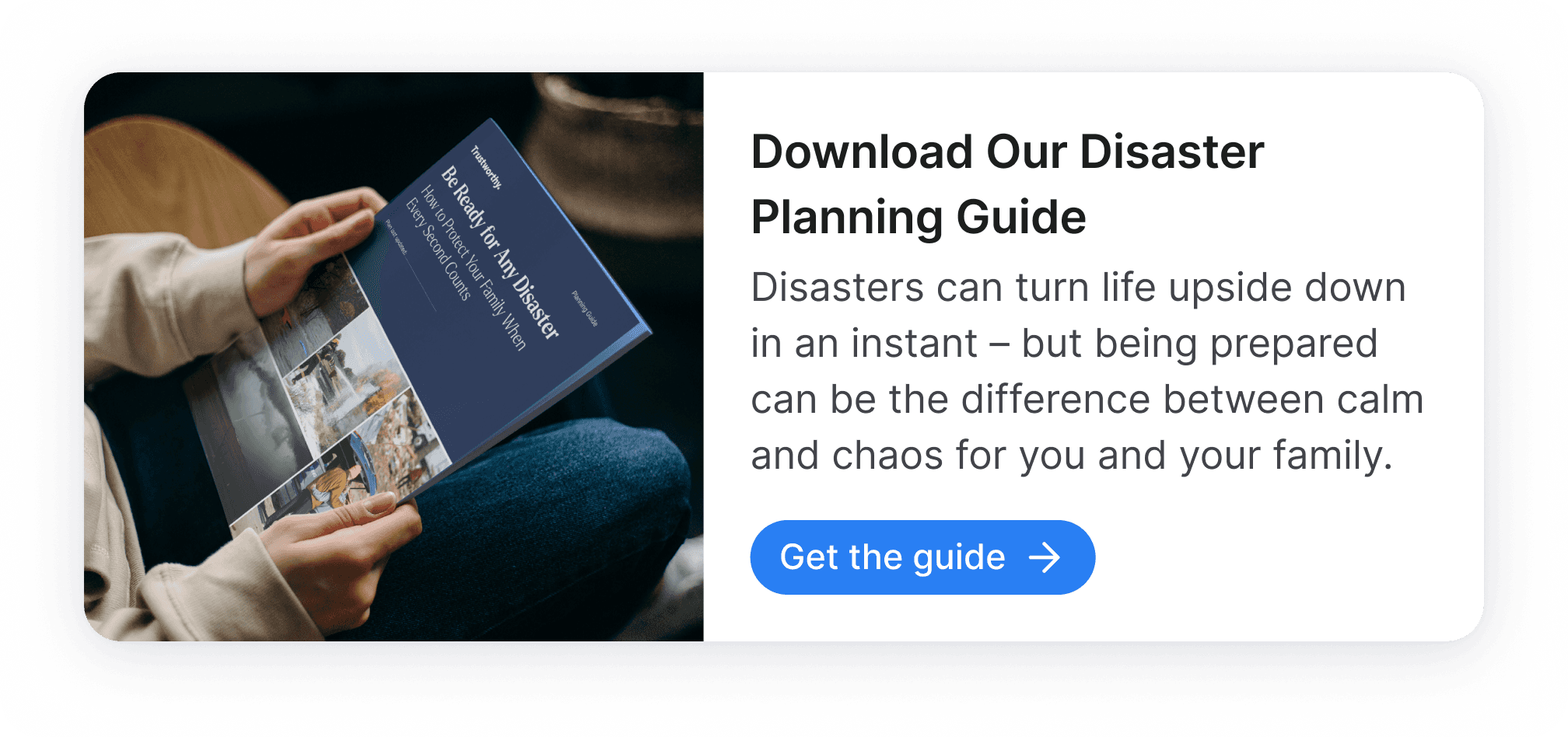
Key Takeaways
Wildfire preparation requires understanding local risk levels through government websites and wildfire maps, identifying at least two evacuation routes in case one is blocked, and creating family communication plans with meeting locations and emergency contacts.
Comprehensive emergency kits should include water (one gallon per person per day for three days), nonperishable food, first-aid supplies, personal hygiene items, clothing and bedding, tools and safety gear, and important documents stored digitally with Trustworthy.
Review wildfire plans at least once a year and after any emergency or drill to ensure current contact information, replenished supplies, and everyone remembers their responsibilities.
Pet and livestock preparation includes creating pet evacuation kits with food, water, leashes, carriers, medications, and medical records, identifying pet-friendly emergency shelters, and planning livestock relocation and transport methods.
Trustworthy provides secure, private, and accessible storage for important documents ensuring quick access during emergencies, better than physical storage that can be lost, damaged, or destroyed during evacuations.

Wildfires are a serious threat to many U.S. communities, making it crucial to have a solid family emergency plan in place. A well-developed wildfire plan may not only ensure your loved ones' safety, but also prepare you to act quickly and effectively when danger strikes.
This article walks through the essential steps for creating a thorough wildfire emergency plan. You'll learn about key components, communication strategies, and how Trustworthy can help you securely store and manage vital family information — ensuring access even in the aftermath of a wildfire.
Getting Started: Risk, Routes, and Communication
Q: How do I know if my area is at risk for wildfires?
A: Begin by understanding the wildfire risk level in your area. Local government websites, wildfire maps, and emergency management offices can provide valuable information. Knowing your area's fire-prone attributes will help you tailor a more effective emergency plan.
Q: What evacuation routes should we plan?
A: Identify at least two evacuation routes from your home in case one is blocked by fire. Make sure everyone in the family is familiar with these routes ahead of time, and consider alternative transportation options if necessary.

Q: How do we create a family communication plan for wildfire emergencies?
A: Your plan should include:
Primary and secondary meeting locations: one nearby, one farther away.
An emergency contact list: local authorities, nearby friends or relatives, and one out-of-town contact.
Communication methods: decide how you’ll reach each other (calls, texts, email, messaging apps).
This plan helps family members reconnect quickly if separated.
Emergency Supplies, Pets, and Document Protection
Q: What should be included in a wildfire emergency kit?
A: A comprehensive emergency kit should include:
Water: one gallon per person per day (minimum of three days).
Food: nonperishable food for at least three days.
First-aid supplies: including prescription medications.
Personal hygiene items: toilet paper, wet wipes, hand sanitizer.
Clothing and bedding: extra clothing, sturdy shoes, sleeping bags.
Tools and safety gear: flashlights, batteries, fire extinguisher, multi-tool.
Important documents: digital storage in Trustworthy for security, privacy, and quick access.
Q: How often should we review our wildfire emergency plan?
A: Review your wildfire plan at least once a year and after any emergency or drill. Regular updates ensure that contact info is current, supplies are replenished, and everyone remembers their responsibilities.
Related: Crafting a Family Emergency Plan

Q: How should we prepare pets and livestock for evacuation?
A: Include animals in your plan:
Pet evacuation kits: food, water, leashes, carriers, medications, and medical records.
Emergency shelters: locations of pet-friendly facilities.
Livestock relocation: transport methods and alternative holding locations.
Q: What’s the best way to store important documents for a wildfire?
A: Use a secure digital vault like Trustworthy to store digital copies of important documents. You’ll be able to access them from any device, even during an evacuation.
Trustworthy also allows controlled sharing, which helps with insurance claims, legal steps, and family communication during recovery.

Building a Complete Wildfire Emergency Plan
Q: What are the core components of a wildfire emergency plan?
A: A strong plan should include:
Evacuation strategy: multiple routes and gathering points.
Emergency contact list: local services, relatives, neighbors, and one out-of-town contact.
Household inventory: documented with photos to support insurance claims.
Roles and responsibilities: assigned duties for each family member.
Regular family meetings: scheduled reviews, drills, and role assignments.
Q: How should we assign family responsibilities during a wildfire?
A: Assign roles ahead of time, such as:
Emergency kit manager: keeps supplies current.
Communication coordinator: shares updates with all family members.
Pet handler: manages pet evacuation.
Evacuation leader: guides everyone along designated routes.
Clear delegation ensures faster action and less confusion during an emergency.
Q: How often should we hold family emergency meetings?
A: Hold meetings at least once or twice a year — more if your area is at high risk. Use these to review your family's procedures, update roles, and conduct mock evacuations. Encourage questions to ensure everyone understands their role.

Q: How can we stay informed about wildfire threats?
A: Stay updated by:
Signing up for local emergency alert systems. Check out Watch Duty, a nonprofit with real-time notification of wildfire threats.
Using emergency alert apps.
Monitoring local government websites and fire department bulletins.
The Bottom Line
A wildfire emergency plan isn’t just about being cautious — it’s about being prepared, informed, and organized when every second counts.
By understanding your local risk, assigning roles, keeping critical documents safe with tools like Trustworthy, and holding regular family meetings, you can make sure your loved ones are protected.
We’d love to hear from you! Feel free to email us with any questions, comments, or suggestions for future article topics.














